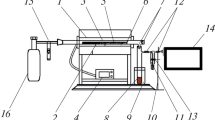Abstract
Earthy and xylytic brown coals from Poland have been sulphonated with 98% sulfuric acid at temperatures of 60°, 90° and 140°C. The main exothemic peak shifts to higher temperatures with increase in sulphonation reaction temperature whereas overall weight loss to 1000°C decreases. DTA curves of earthy and xylytic coals sulphonated at higher temperatures are similar, even though DTA curves of the unmodified coals differ appreciably. Thermal decomposition of earthy coal oxidized by nitric acid follows a different pattern. Nitric acid causes oxidation and depolymerization of the organic components and this is reflected in the shapes of DTA and TG curves of oxidized coals. As the nitric acid concentration and reaction temperature increase, the main exothermic peak shifts to lower temperatures (from 330°C for basic coal to 270°C for coal oxidized with 30 and 50% nitric acid). The weight loss is higher for oxidized coal than for coal unmodified by nitric acid.
Zusammenfassung
Aus Polen stammende Erd- und xylitische Braunkohle wurde bei einer Temperatur von 60°, 90° und 140°C mit 98%-iger Schwefelsäure sulfoniert. Der größte exotherme Peak verschiebt sich in Richtung höherer Temperaturen wenn die Sulfonierungsreaktions-temperatur erhöht wird., während der Gesamtgewichtsverlust bis 1000°C abnimmt. Die DTA-Kurven von bei höheren Temperaturen sulfonierten Erd- und xylitischen Braunkohlen ähneln einander, wenn sie auch von den DTA-Kurven der nicht modifizierten Kohlen beträchtlich abweichen. Die thermische Zersetzung von mittels Salpetersäure oxidierter erdiger Kohle zeigt einen anderen Verlauf. Salpetersäure verursacht eine Oxidierung und Depolymerisierung der organischen Komponenten und dies spiegelt sich in den Verläufen der DTA- und TG-Kurven der oxidierten Kohlen wieder. Steigen Salpetersäurekonzentration und Reaktionstemperatur an, verschiebt sich der höchste exotherme Peak in Richtung niedrigerer Temperaturen (von 330°C für die Basiskohle auf 270°C für die mit 30 und 50%-iger Salpetersäure oxidierte Kohle). Der Gewichtsverlust ist für die mit Salpetersäure, modifizierte Kohle höher als bei der unmodifizierten Kohle.
Similar content being viewed by others
References
H. Martyniuk and D. Augustyn, Fuel, 70 (1991) 551.
J. Wieckowska, Thermochim. Acta, 134 (1988) 359.
J. Wieckowska, Thermochim. Acta, 148 (1988) 541.
H. Martyniuk, Koks Smola Gaz, 36 (1991) 138.
H. Martyniuk and D. Augustyn, Koks Smola Gaz, 34 (1989) 98.
H. Martyniuk and K. Tomków, Koks Smola Gaz, 28 (1983) 221.
Author information
Authors and Affiliations
Rights and permissions
About this article
Cite this article
Martyniuk, H., Wieckowska, J. A study of sulphonated and oxidized coals by thermal analysis. Journal of Thermal Analysis 40, 217–224 (1993). https://doi.org/10.1007/BF02546572
Published:
Issue Date:
DOI: https://doi.org/10.1007/BF02546572




